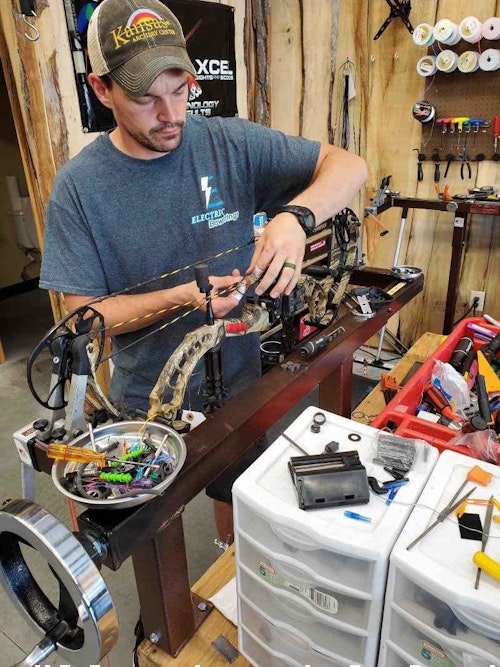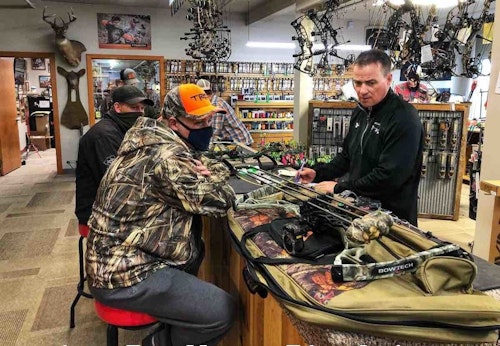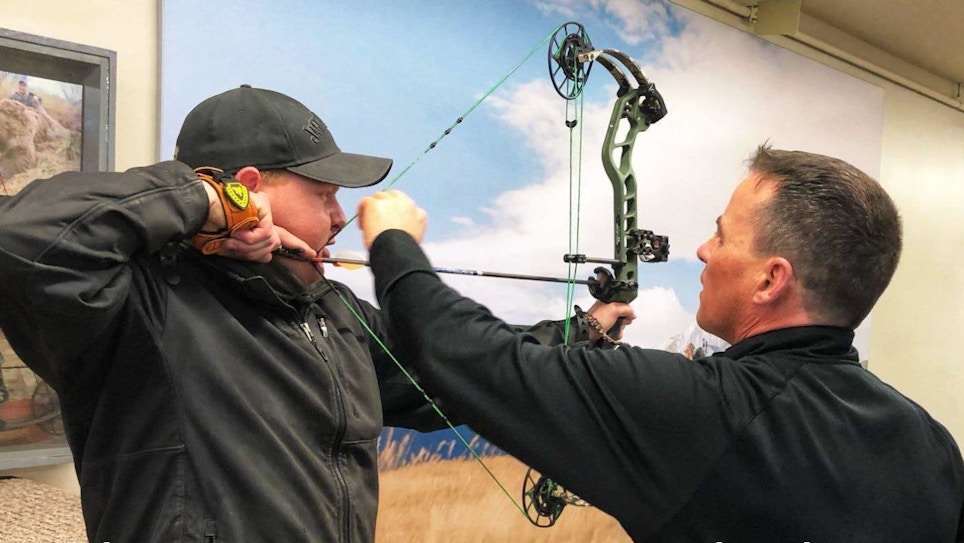It is a story as old as time, the small guy versus the overwhelming giant. You see it unfolding in everything from politics to sports. It is especially evident in the world of business. The mere mention of Amazon sends many business owners into a tailspin of gloom.
Sporting goods stores face a similar battle. You know the names of the large, box-style stores within a short drive of your zip code. They offer everything from archery mercantile to a selection of candy at the checkout. As a small business owner in the archery universe, you can’t compete with their overall size and stocking budget, but you can compete with their personality. Instead of cursing at their presence, look at them as a helpful originator of customers when personality in the large aisles gets lost like the occasional Amazon package at UPS.
The National Federation of Independent Business re-published an article on its website written by Ball State University professor Michael Hicks titled “5 Ways Small Businesses Can Compete With Big-Box Stores.” It provides an evaluation format to help you gauge your strategy against the giant down the street.
First, Hicks explains that you must go niche. He is basically describing what you are already advertising — a store focused on archery and not on everything from camping to baseball. Next, he advises small businesses to take the high road. Offer a higher quality of merchandise than the limited and discounted selection you might find at the local Walmart. His third suggestion is where your personality can shine: stress service. This is the one area that large stores have difficulty in achieving with consistency. A few stand out in this area, but as a small archery outlet you need to be known for competent service that is available whenever your “open” sign is lit. Fourth in recommendations is to dabble in delivery. Hicks’ message is to follow the example of Amazon and others. Instead of stocking everything, stock enough to spark a sale and then have a network established to order with speedy efficiency to meet a specific size, or model. That helps your stocking budget, but deliver speedily.
Finally, the article recommends you complement to complete. Depending on your location, it is likely that a major box store is a short drive down the road or even just across the parking lot. Those large stores may get first attention by customers, but when they cannot deliver, then your personality gives you a chance at bat to make a sale.
Customers First
Jim Carlsen owns the Kansas Archery Center (www.ksarcherycenter.com) located in Manhattan. Educated as a flight nurse and paramedic, Carlsen had a small, “side-hustle” archery shop since 2013. He has also participated in competitive archery since 2000. In 2018 an opportunity in Manhattan arose, and with the blessing of his wife, Sidney, Carlsen jumped full-time into the archery business venture. The business he purchased had been in the area for several decades, but required a professional approach to make it lucrative. Carlsen made that his main goal. A starting point for him and his employees is to always listen to the customer first.
“I believe you always should be listening to the customer,” Carlsen said. “They know what they are looking for, so listen to them first instead of telling them what they need. When they ask what you think, tell them in a positive way why you like what you like, and never talk down to them. I make sure my employees are on the same wavelength. We are here to help; not tell our customers they are idiots. It sounds like common sense, but you do hear about bad things that happen in other stores, and apparently it is a common complaint.”
To ensure the customer is first, Carlsen demands his employees are informed about all the products in stock. To him, knowing the catalog description and pricing is not enough. Employees are required to study up on the product so they can intelligently describe why it would help a customer and why it costs more than a cheaper version they may be considering.
Archery shop owner Al Kraus has been operating Black Hills Archery (www.blackhillsarchery.net) in South Dakota since 1998. The business was established a decade prior. Kraus makes it simple when training employees on customer service. He merely tells every new employee to treat customers the way they would want to be treated, and never lie if you do not know the answer to the question being asked.
“If you don’t know the answer to a customer’s question, never lie your way around,” Kraus said. “I tell my employees to simply respond that it’s a good question and I’ll need to look into it. Honesty with everybody is best, and it is definitely important for me, and my business.”

To help employees understand inventory, Kraus is adamant about selling gear he believes in. He will not stock items just to make a sale if it will not perform in the field or at the range. That doesn’t he will not stock to compete with the other outlets around him. In fact, he often stocks the same merchandise and for a simple reason: When customers compare, they see they can purchase the same items competitively and receive set up, plus instruction. Big box stores oftentimes cannot fulfill that mission.
“If it is the same bow at the same price, I can get the sale because it is one-stop shopping with service,” said Kraus.
Carlsen strives to keep pricing competitive with other outlets. He must because nearly every customer compares prices online. Many even walk around his shop with smartphone in hand looking up prices of bows and gear. Fortunately, he has yet to hear someone complain about pricing.
“Generally speaking, nobody tells me that my prices are widely out of line. Instead, they say I’m competitive,” Carlsen said. “I don’t price to sell lots. I just try to stay competitive. You have to make money. And the majority of the people know if they are paying $5 more, they are getting way more with the service provided.”
He’s also grateful for the Midwestern ethic of shopping locally. Not only does his shop have a steady, local clientele, but many will even allow him to order something that may be out of stock for this reason: “They say they want to give their money to a local small business. I love hearing that.”

Customer Service
Carlsen understands he isn’t the only archery game in town. In fact, he competes with Dick’s Sporting Goods, Academy Sports and Cabela’s in nearby Kansas City, to name a few. Still, he doesn’t view these necessarily as competition, and looks at all archery outlets as a way to introduce more people to the sport. Fortunately, as oftentimes is the case, the larger the store, the less it can offer in customer service. That is where shops such as Black Hills Archery and Kansas Archery Center shine as hinted at earlier.
“Customer service with those big box stores can be sketchy,” Kraus said. “It’s not like a rifle sale where you set it up and push the customer out the door. You need customer service with a bow because you have to spend time fitting it to the customer, including draw length, draw weight and lessons on how to shoot properly.”
Carlsen’s best customer service example comes from a larger, nearby sporting goods store. One of their younger employees is a regular visitor to the Kansas Archery Center range. While conversing one day, the young shooter said he routinely tells customers to come down to Carlsen’s store for service issues. With an honest admission, he said he did not know enough about archery service to be working on equipment and neither did his coworkers at the bigger retailer.
“I’m aware that someone new to the sport may not be willing to spend a lot of money getting started,” Carlsen said. “They are purchasing a $300 bow and hopefully will fall in love with the sport. When they need service or are ready to upgrade to a midrange or higher priced bow, it is good for me because I am their next stop.”
Kansas Archery Center service also includes string building. Carlsen receives many kudos for that talent. Bowhunters or crossbow hunters can be assured of a replacement string that is tailored to their model without any special orders. In fact, the store is closed on Sunday and Monday, but during those days Carlsen typically is in the shop building strings and even answers the phone to help customers with emergencies when he isn’t underwater with string building.
Both Carlsen and Kraus take employee training to heart. Instead of sending new pro shop techs to various schools, they spend time with new hires in apprenticeship roles. Both have worked on bows for decades and stay up to speed on the intricacies of new models. Kraus’ latest hire is a good example.
“I’m working with a high school kid who started shooting in my 4-H program when he was just 8,” Kraus said. “He spends a lot of time at the shop shooting 3-D and targets. Now he is interested in being a tech at the shop, so we have taken him under our wings and getting him the hands-on training he needs to be our next technician.”

Customer Incentive
Free shipping, buy one and get one free, Taco Tuesday and other favorite customer incentives lure you back to a particular venue for repeat business. Small stores relying on every dollar may not be inclined to offer too many deals-of-the-day, but Carlsen has implemented a few programs to incentivize repeat customer purchases.
“Last year, I stumbled across a program in my point-of-sales system,” Carlsen said. “It creates a profile for every individual customer, and it had a rewards program attached. One day I started studying it and set the parameters for the reward system. Now it tracks every customer’s purchase.”
The program is from QuickBooks and allows customers to return purchases without a receipt. Better yet, for every $250 a customer spends, they get a 10 percent reward that is good for one year. Carlsen says it has been a big boon to sales and customers love it.
To make additional income and expand his reach across the country, Carlsen also operates an online store through eBay. He is working on integration of the store to be on his website soon. He sells nearly everything, but his main push is to contact bow manufacturers and purchase bow models that are one, or two years old. He will purchase a pallet of bows if available.
Manufacturers are eager to reduce inventory and he buys at the right price and prices to move the inventory quickly via free shipping. For him, it is a way to keep an active income stream during slow times and build his business simultaneously.
Kraus takes a more straightforward approach to customer incentives. His motto is to treat everyone the same: “My goal is to offer the same prices to everyone and take care of everyone equally who walks through the front door of my shop. I have a sign on the back of our bow press that has been there for years. It states to appreciate every customer because they chose to come to Black Hills Archery. In brief, we just take care of everyone.”

Little Things for the Customer and Community
Large box stores and corporations sometimes have the backing to make a big difference in community commitment. But sometimes the red tape hampers that output as well. Small archery shops have more flexibility, and both Kraus and Carlsen see benefit to helping with community projects. One of their biggest outreach programs is by helping the local 4-H Shooting Sports with their archery disciplines at their indoor ranges.
“Obviously, my youth program is the biggest thing I do for the Rapid City community,” Kraus stressed. “I literally have one of the largest youth programs in the U.S., and have been coordinating it since I took over the store in 1998.”
Kraus has also been on the board of directors for the South Dakota Youth Hunting program for the past 14 years. This mentoring program offers an avenue to the outdoors for youth who do not have an easy way to experience hunting, fishing, shooting sports and other outdoor activities. Finally, Kraus helps coordinate the youth archery tournament at the Rapid City annual sport show. Between 400 and 500 youth from all over state come to compete in this youth-only competition.
Carlsen’s archery range is set up for 24-hour access. With a membership, anyone can shoot at any time, and he also has the 4-H Shooting Sports archery program utilizing the indoor setting. To further promote community youth shooting sports, Carlsen offers a kids’ league. Youth can bring their own equipment, but if they don’t have gear, he supplies anyone with the needed items to participate.
“I do what I call a kids’ league,” Carlsen explained. “I provide all the equipment to use, or they can bring their own. Most are kids who have never shot before, so it is more about lessons and fun as kids learn about target archery. I believe this is big-picture stuff to help promote the sport and enjoyment of archery.”
Personality falls right into this “big-picture” persona. Make sure your archery shop conveys a touch of personality to keep customers coming back for more.






